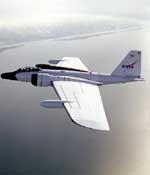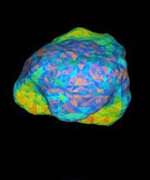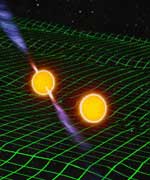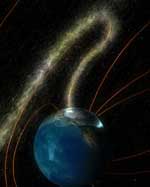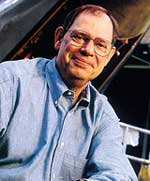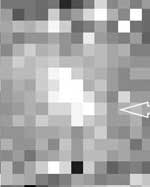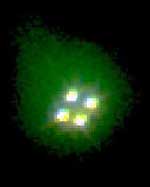
Image credit: NRAO
One of the most distant galaxies ever seen seems to be in the midst of extremely active star formation. The galaxy has been dubbed the Cloverleaf, and it’s 11 billion light-years away, so astronomers are seeing it when the Universe was less than 3 billion years old. It has a rate of star formation 300 times greater than our own Milky Way – 1,000 new stars are being formed each year. The discovery was made using the National Science Foundation’s Very Large Array radio telescope.
Astronomers have discovered a key signpost of rapid star formation in a galaxy 11 billion light-years from Earth, seen as it was when the Universe was only 20 percent of its current age. Using the National Science Foundation’s Very Large Array (VLA) radio telescope, the scientists found a huge quantity of dense interstellar gas — the environment required for active star formation — at the greatest distance yet detected.
A furious spawning of the equivalent of 1,000 Suns per year in a distant galaxy dubbed the Cloverleaf may be typical of galaxies in the early Universe, the scientists say.
“This is a rate of star formation more than 300 times greater than that in our own Milky Way and similar spiral galaxies, and our discovery may provide important information about the formation and evolution of galaxies throughout the Universe,” said Philip Solomon, of Stony Brook University in New York.
While the raw material for star formation has been found in galaxies at even greater distances, the Cloverleaf is by far the most distant galaxy showing this essential signature of star formation. That essential signature comes in the form of a specific frequency of radio waves emitted by molecules of the gas hydrogen cyanide (HCN).
“If you see HCN, you are seeing gas with the high density required to form stars,” said Paul Vanden Bout of the National Radio Astronomy Observatory (NRAO).
Solomon and Vanden Bout worked with Chris Carilli of NRAO and Michel Guelin of the Institute for Millimeter Astronomy in France. They reported their results in the December 11 issue of the scientific journal Nature.
In galaxies like the Milky Way, dense gas traced by HCN but composed mainly of hydrogen molecules is always associated with regions of active star formation. What is different about the Cloverleaf is the huge quantity of dense gas along with very powerful infrared radiation from the star formation. Ten billion times the mass of the Sun is contained in dense, star-forming gas clouds.
“At the rate this galaxy is seen to be forming stars, that dense gas will be used up in only about 10 million years,” Solomon said.
In addition to giving astronomers a fascinating glimpse of a huge burst of star formation in the early Universe, the new information about the Cloverleaf helps answer a longstanding question about bright galaxies of that era. Many distant galaxies have super-massive black holes at their cores, and those black holes power “central engines” that produce bright emission. Astronomers have wondered specifically about those distant galaxies that emit large amounts of infrared light, galaxies like the Cloverleaf which has a black hole and central engine.
“Is this bright infrared light caused by the black-hole-powered core of the galaxy or by a huge burst of star formation? That has been the question. Now we know that, in at least one case, much of the infrared light is produced by intense star formation,” Carilli said.
The rapid star formation, called a starburst, and the black hole are both generating the bright infrared light in the Cloverleaf. The starburst is a major event in the formation and evolution of this galaxy.
“This detection of HCN gives us a unique new window through which we can study star formation in the early Universe,” Carilli said.
The National Radio Astronomy Observatory is a facility of the National Science Foundation, operated under cooperative agreement by Associated Universities, Inc.
Original Source: NRAO News Release

